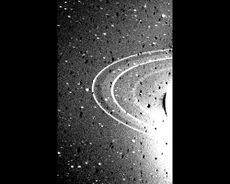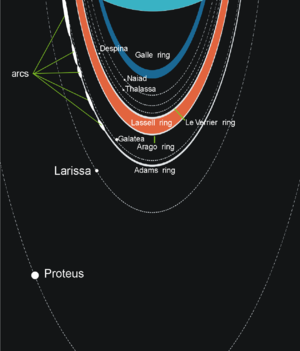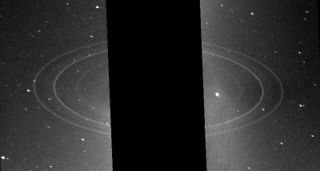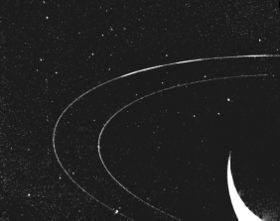حلقات نپتون
حلقات نپتون تتألف أساساً من خمس حلقات رئيسية توقعها في 1984 أندريه براهيتش وصوّرتها في 1989 المركبة الفضائية ڤويدجر 2.[1] At their densest, they are comparable to the less dense portions of Saturn's main rings such as the C ring and the Cassini Division, but much of Neptune's ring system is quite tenuous, faint and dusty, more closely resembling the rings of Jupiter. Neptune's rings are named after astronomers who contributed important work on the planet:[1] Galle, Le Verrier, Lassell, Arago, and Adams.[2][3] Neptune also has a faint unnamed ring coincident with the orbit of the moon Galatea. Three other moons orbit between the rings: Naiad, Thalassa and Despina.[3]
The rings of Neptune are made of extremely dark material, likely organic compounds processed by radiation, similar to that found in the rings of Uranus.[4] The proportion of dust in the rings (between 20% and 70%) is high,[4] while their optical depth is low to moderate, at less than 0.1.[5] Uniquely, the Adams ring includes five distinct arcs, named Fraternité, Égalité 1 and 2, Liberté, and Courage. The arcs occupy a narrow range of orbital longitudes and are remarkably stable, having changed only slightly since their initial detection in 1980.[4] How the arcs are stabilized is still under debate. However, their stability is probably related to the resonant interaction between the Adams ring and its inner shepherd moon, Galatea.[6]
الاكتشاف والرصد
عـُثر على حلقات خافتة ذات لون أزرق سماوي حول الكوكب الأزرق، إلا أنهم أقل وضوحاً بكثير من حلقات زحل. وحين اُكتشفت تلك الحلقات بواسطة فريق بقيادة إدوارد گينان، فقد كان يُظَن أنهم حلقات غير كاملة. إلا أن ذلك قد ثبت خطأه بصور ڤويدجر-2.
لنبتون ثلاث حلقات واضحة واثنتان خافتتان. وهذه الحلقات كلها أخفت وأظلم بكثير من حلقات زحل، لكنها تتركب من الغاز مثل حلقات زحل. والحلقات الخارجية لنبتون ليس لها مثيل داخل المجموعة الشمسية، فكل حلقة مغطاة بثلاث قطع ألمع وأكبر كثافة عن بقية الحلقات.
الصفات العامة

الحلقات الداخلية
حلقة أدمز
الأقواس
الاستكشاف
الخصائص
| اسم الحلقة | نصف القطر (كم)[3] | العرض (كم) | العمق المكافئ (كم)[b][c] | N. Opt. depth[a] | كسر الغبار،%[7] | Ecc. | Incl.(°) | ملاحظات |
|---|---|---|---|---|---|---|---|---|
| Galle (N42) | 40,900–42,900 | 2,000 | 0.15[4] | ~ 10−4[4] | 40–70 | ? | ? | حلقة شاحبة عريضة |
| Le Verrier (N53) | 53,200 ± 20 | 113[5] | 0.7 ± 0.2[5] | 6.2 ± 1.5 × 10–3[5] | 40–70 | ? | ? | Narrow ring |
| Lassell | 53,200–57,200 | 4,000 | 0.4[4] | ~ 10−4[4] | 20–40 | ? | ? | Lassell ring is a faint sheet of material stretching from Le Verrier to Arago |
| Arago | 57,200 | <100[4] | ? | ? | ? | ? | ? | |
| Adams (N63) | 62,932 ± 2 | 15–50[5] | 0.4[4] 1.25–2.15[5] (in arcs) |
0.011 ± 0.003[5] 0.03–0.09[4] (in arcs) |
20–40 40–70 (in arcs) |
4.7 ± 0.2 × 10–4[8] | 0.0617 ± 0.0043[8] | Five bright arcs |
*A question mark means that the parameter is not known.
ملاحظات
a The normal optical depth τ of a ring is the ratio of the total geometrical cross-section of the ring's particles to the area of the ring. It assumes values from zero to infinity. A light beam passing normally through a ring will be attenuated by the factor e–τ.[9]
b The equivalent depth ED of a ring is defined as an integral of the normal optical depth across the ring. In other words ED = ∫τdr, where r is radius.[10]
c The equivalent depth of Galle and Lassell rings is a product of their width and the normal optical depth.
d The corotation inclination resonance (CIR) of the order m between a moon on inclined orbit and a ring occurs if the pattern speed of the perturbing potential (from a moon) equals the mean motion of the ring particles . In other words the following condition should be met , where and are the nodal precession rate and mean motion of the moon, respectively.[8] CIR supports 2m stable sites along the ring.
e The corotation eccentricity resonance (CER) of the order m between a moon on eccentric orbit and a ring occurs if the pattern speed of the perturbing potential (from a moon) equals the mean motion of the ring particles . In other words the following condition should be met , where and are the apsidal precession rate and mean motion of the moon, respectively.[11] CER supports m stable sites along the ring.
f The longitude system is fixed as of 18 August 1989. The zero point corresponds to the zero meridian on Neptune.[3]
g Forward-scattered light is light scattered at a small angle relative to solar light. Back-scattered light is light scattered at an angle close to 180° (backwards) relative to solar light. The scattering angle is close to 90° for side-scattered light.
References
- ^ أ ب Miner, Ellis D., Wessen, Randii R., Cuzzi, Jeffrey N. (2007). "The discovery of the Neptune ring system". Planetary Ring Systems. Springer Praxis Books. ISBN 978-0-387-34177-4.
{{cite book}}: CS1 maint: multiple names: authors list (link) - ^ Listed in increasing distance from the planet
- ^ أ ب ت ث Miner, Ellis D., Wessen, Randii R., Cuzzi, Jeffrey N. (2007). "Present knowledge of the Neptune ring system". Planetary Ring System. Springer Praxis Books. ISBN 978-0-387-34177-4.
{{cite book}}: CS1 maint: multiple names: authors list (link) - ^ أ ب ت ث ج ح خ د ذ ر
DOI:10.1126/science.246.4936.1422
This citation will be automatically completed in the next few minutes. You can jump the queue or expand by hand - ^ أ ب ت ث ج ح خ Horn, Linda J. (1990). "Observations of Neptunian rings by Voyager photopolarimeter experiment". Geophysics Research Letters. 17 (10): 1745–1748. Bibcode:1990GeoRL..17.1745H. doi:10.1029/GL017i010p01745.
{{cite journal}}: Unknown parameter|coauthors=ignored (|author=suggested) (help) - ^ Burns, J.A. (2001). "Dusty Rings and Circumplanetary Dust: Observations and Simple Physics" (pdf). In Grun, E.; Gustafson, B. A. S.; Dermott, S. T.; Fechtig H. (ed.). Interplanetary Dust. Berlin: Springer. pp. 641–725.
{{cite encyclopedia}}: Unknown parameter|coauthors=ignored (|author=suggested) (help)CS1 maint: multiple names: editors list (link) - ^ Colwell, Joshua E. (1990). "A model of dust production in the Neptunian ring system". Geophysics Research Letters. 17 (10): 1741–1744. Bibcode:1990GeoRL..17.1741C. doi:10.1029/GL017i010p01741.
{{cite journal}}: Unknown parameter|coauthors=ignored (|author=suggested) (help) - ^ أ ب ت Porco, C.C. (1991). "An Explanation for Neptune's Ring Arcs". Science. 253 (5023): 995–1001. Bibcode:1991Sci...253..995P. doi:10.1126/science.253.5023.995. PMID 17775342.
- ^ Ockert, M.E. (1987). "Uranian ring photometry: Results from Voyager 2". Journal of Geophysical Research. 92 (A13): 14, 969–78. Bibcode:1987JGR....9214969O. doi:10.1029/JA092iA13p14969.
{{cite journal}}: Unknown parameter|coauthors=ignored (|author=suggested) (help) - ^ Holberg, J.B. (1987). "Stellar occultation probes of the Uranian rings at 0.1 and 2.2 μm – A comparison of Voyager UVS and earth-based results". The Astronomical Journal. 94: 178–188. Bibcode:1987AJ.....94..178H. doi:10.1086/114462.
{{cite journal}}: Unknown parameter|coauthors=ignored (|author=suggested) (help) - ^ Namouni, Fathi (2002). "The confinement of Neptune's ring arcs by the moon Galatea". Nature. 417 (6884): 45–47. doi:10.1038/417045a. PMID 11986660.
{{cite journal}}: Unknown parameter|coauthors=ignored (|author=suggested) (help)
خطأ استشهاد: الوسم <ref> ذو الاسم "Nicholson1990" المُعرّف في <references> غير مستخدم في النص السابق.
خطأ استشهاد: الوسم <ref> ذو الاسم "dePater2005" المُعرّف في <references> غير مستخدم في النص السابق.
خطأ استشهاد: الوسم <ref> ذو الاسم "Dumas1999" المُعرّف في <references> غير مستخدم في النص السابق.
خطأ استشهاد: الوسم <ref> ذو الاسم "Sicardy1991" المُعرّف في <references> غير مستخدم في النص السابق.
خطأ استشهاد: الوسم <ref> ذو الاسم "Hedman2007" المُعرّف في <references> غير مستخدم في النص السابق.
خطأ استشهاد: الوسم <ref> ذو الاسم "Showalter2005" المُعرّف في <references> غير مستخدم في النص السابق.
خطأ استشهاد: الوسم <ref> ذو الاسم "Sicardy1999" المُعرّف في <references> غير مستخدم في النص السابق.
خطأ استشهاد: الوسم <ref> ذو الاسم "Salo1998" المُعرّف في <references> غير مستخدم في النص السابق.
خطأ استشهاد: الوسم <ref> ذو الاسم "Galle" المُعرّف في <references> غير مستخدم في النص السابق.
خطأ استشهاد: الوسم <ref> ذو الاسم "LeVerrier" المُعرّف في <references> غير مستخدم في النص السابق.
خطأ استشهاد: الوسم <ref> ذو الاسم "Lassell" المُعرّف في <references> غير مستخدم في النص السابق.
خطأ استشهاد: الوسم <ref> ذو الاسم "Arago" المُعرّف في <references> غير مستخدم في النص السابق.
<ref> ذو الاسم "Adams" المُعرّف في <references> غير مستخدم في النص السابق.









